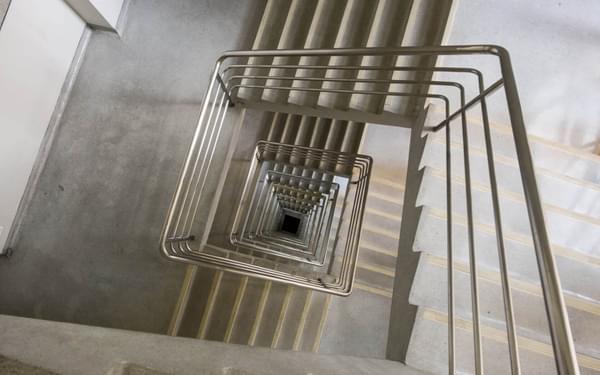
How could important information about a purpose built, high profile public building be lost?
It sounds nearly impossible in this digital day and age, but at some point between the start of construction in 2007 and last year, the drawings and data for the Olympic Stadium in London went missing. Since its starring role as the venue for track and field events and the opening and closing ceremonies of the 2012 Olympic Games, the stadium has been renovated for multi-purpose use, and is now the home of West Ham United.
But in 2022, a survey company was asked to carry out a digital survey as the existing client could not find the drawings. But how - when the designers and contractors are known - could such an iconic piece of the built environment be missing this key information? Where are the as-builts? Who has the drawings? We know that they must have existed at some point, because the Olympic Delivery Authority apparently had a set.
If this can happen with a major public building built just 15 years ago, what hope does an ordinary block of flats several decades old have? Why does it even matter where a building's records are?
The Building Safety Act legally requires all in scope buildings to have an accurate, detailed digital golden thread of information - whether new or existing.
A golden thread is a comprehensive record of every stage of a building's life, securely stored as accessible, structured digital information. One of the core aims of the digital golden thread is ensuring the right people have the right information at the right time, so that the safety of occupants can be prioritised. It should bring all relevant data, including drawings, specifications, updates and any other information into one place, acting as the single source of truth for that building.
The Building Safety Act initially applies to high-risk buildings; that is, all residential buildings over 18m or seven storeys in height that contain two or more dwellings, along with hospitals and care homes.
There are estimated to be around 13,000 such existing buildings, all in need of a solid, dependable golden thread that acts as a trail of accountability for those responsible for the building. But, as even the Olympic Stadium demonstrates, with potentially incomplete or missing data and decades of changing ownership, collating this thread for existing buildings could prove to be something of a challenge.
Enter, the digital twin.
What is a digital twin?
Digital twin technology has been used for some time in other large scale industries including manufacturing, energy and supply chain management. It creates a detailed virtual replica of a physical asset or system, which can be used to visualise, monitor, analyse and manage its data in real-time.
In our industry, platforms such as Twinview or Twinit.io provide immersive 3D views of a building, allowing a deeper understanding of its design and construction. It can monitor conditions and identify trends, tracking changes over time, along with pinpointing areas that are high-risk factors so that corrective action can be taken before a problem becomes more significant.
By utilising digital twin technology, building owners and operators can easily collect, visualise, analyse, and manage vast amounts of data. They can use it to ensure that the building is properly maintained throughout its lifecycle, ensuring the safety of the occupants, whilst optimising the building's performance for efficiency and comfort.
This data, generated by a digital twin, can also plug any missing gaps in historic records, strengthening and enriching the golden thread, and helping building owners and operators to comply with the new regulatory requirements
How to create an accurate digital golden thread for existing buildings
In order to create a digital twin or a digital shadow we first need accurate design information.
While new projects can incorporate a digital golden thread from the start, creating an accurate digital golden thread for existing buildings could involve collecting and consolidating data from a variety of sources, some of which may be incomplete or outdated. However, there are several steps that can be taken:
- Conduct a thorough survey:
The first step in creating a digital golden thread for an existing building is to conduct a thorough survey of the building, including its structure, systems, and components. Some businesses, such as Platinum 3D, can scan the entire building to create a 3D digital model. These surveys should capture as much data as possible about the building, including its age, construction materials, and any modifications that have been made over time.
- Gather historical data from a range of sources:
In addition to the survey, data can also be collected from various sources, such as building maintenance records, inspection reports, and occupant feedback. This data should be consolidated and organised in a way that makes it easy to access and use.
- Use standardised data formats:
To ensure that the data in the digital golden thread is accurate and consistent, it is important to use standardised data formats that are recognised across the industry. This can help to ensure that the data is easily understood and can be used by a variety of stakeholders, such as designers, contractors, and building owners.
Standardised data formats are critical to the effective use and sharing of construction data across the industry. In the UK, there are several key standards that are recognized across the industry, including:- Construction Operations Building Information Exchange (COBie): COBie is a data format that is used to share information about building assets between different stakeholders, such as designers, contractors, and building owners. It is designed to capture and organize data in a standardised format that can be easily understood and used.
- Industry Foundation Classes (IFC): IFC is an open data format that is used to exchange building information between different software applications. It allows for the sharing of data about building geometry, components, materials, and other attributes, and is designed to enable information to flow between different systems.
- Uniclass is a classification system that is used to organize construction information into a standardised structure. It is used to classify products, systems, and processes across the construction industry and is designed to promote consistency and clarity in the use of construction information.
- National Building Specification (NBS): NBS is a specification system that is used to provide detailed information about construction products and processes. It includes standardised templates and guidelines for the production of construction specifications, and is widely used across the industry to ensure that construction projects are carried out to a high standard.
Overall, these and other standardised data formats are critical to the effective sharing and use of construction data across the industry. They help to promote consistency and clarity in the use of construction information, and enable different stakeholders to work together more effectively to deliver high-quality construction projects. While some firms use them well, widespread adoption of these processes across the industry is still a way off.
- Construction Operations Building Information Exchange (COBie): COBie is a data format that is used to share information about building assets between different stakeholders, such as designers, contractors, and building owners. It is designed to capture and organize data in a standardised format that can be easily understood and used.
- Utilise digital technologies:
The use of digital technologies, such as Building Information Modelling (BIM) and Geographic Information Systems (GIS), can help to create a more accurate and comprehensive digital golden thread. These technologies allow for the integration of different data sources and provide a more detailed picture of the building's structure and systems. - Regularly update the digital golden thread:
Finally, it is important to regularly update the digital golden thread as new data becomes available. This can help to ensure that the digital golden thread remains accurate and relevant over time and can be used to inform decision-making and improve the safety and sustainability of the building.
Start a digital golden thread now
It is expected that the Building Safety Act will extend across multiple sectors over the next decade or so, eventually applying to all buildings. Bearing that in mind, all projects (regardless of sector) currently in progress ought to be prioritising quality and accessibility of building data from now onwards, so that the task is not mammoth when the building is inevitably required to compile a digital golden thread. We’ve seen just how quickly high-profile data can be lost.
For existing residential higher-risk buildings, the scale of the mountain to climb is becoming apparent. RICS has acknowledged that it may struggle to recruit enough surveyors to undertake the amount of work necessary on such buildings. All existing in-scope buildings should now, at the very least, be registered with the Building Safety Regulator. Secondary legislation that further clarifies the requirements of the digital golden thread is expected to be released in waves across autumn 2023.
It is clear that there are complex challenges around creating an accurate digital golden thread for existing buildings. An extensive combination of surveying, data collection and consolidation, standardised data formats, digital technologies, along with regular updating, are required.
The benefits of having an accurate and comprehensive digital golden thread for existing buildings are significant, ultimately resulting in improved safety, sustainability and efficiency.
Building Safety Act: latest news
Stay informed with our dedicated newsletter featuring coverage from our conference and other quality content.












